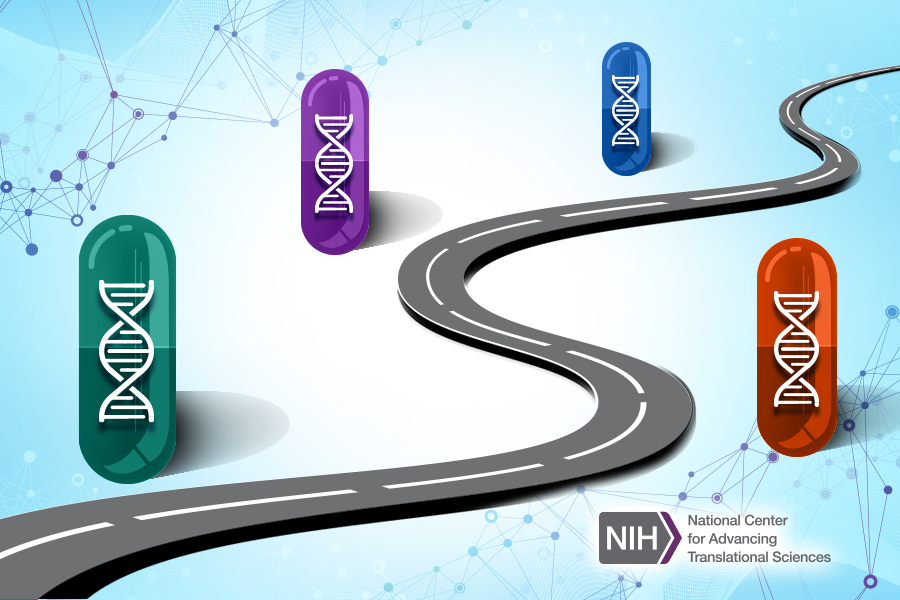NIH Gene Therapy Team Reveals Its Path to FDA Orphan Drug and Rare Pediatric Disease Designations

(NCATS)
March 29, 2023
Platform Vector Gene Therapy project researchers begin to demystify the regulatory process of developing a gene therapy for a rare disease.
When NCATS received an Orphan Drug Designation (ODD) from the U.S. Food and Drug Administration (FDA), it marked a key accomplishment for researchers in the NIH's Platform Vector Gene Therapy (PaVe-GT) project. NCATS received the ODD for PaVe-GT's AAV9-hPCCA (NCATS-BL0746) investigational gene therapy to treat a form of propionic acidemia, a rare metabolic disorder.
“An ODD is a very important development incentive, given the low number of approved products for the thousands of rare diseases,” said Charles Venditti, M.D., Ph.D., a senior investigator at the National Human Genome Research Institute. Venditti is principal investigator for the PaVe-GT propionic acidemia project.
An ODD provides financial incentives to make it easier to bring a drug or therapy to market. These incentives include a waiver of the FDA New Drug Application or Biologics License Application, which can cost more than $3 million. Companies receive tax credits and are given seven years to market a drug.
NCATS also received a Rare Pediatric Disease (RPD) designation for propionic acidemia. This is a key step in getting a Priority Review Voucher, which can be granted when a drug is approved. The voucher serves as another incentive for rare disease drug development. It can be used to receive a priority review of a later marketing application for a different product. It also can be sold.
Launched in 2019, PaVe-GT is building a blueprint for gene therapy development and clinical testing. The goal is to make the process more efficient and easier to access for people with rare diseases. Now, PaVe-GT scientists are starting to share what they have learned in hopes of speeding others' work in this field.
“We aim to demystify the gene therapy development process,” said Elizabeth Ottinger, Ph.D., acting director of the NCATS Therapeutic Development Branch. Ottinger leads the preclinical development and regulatory efforts for all four projects within PaVe-GT.
In Human Gene Therapy, Venditti, Ottinger and others described what went into the successful ODD and RPD applications. “Applicants must explain why the orphan drug qualifies to receive an ODD. They have to thoroughly describe the U.S. patient population size and experimental data showing potential effectiveness of the new drug or therapy,” Ottinger said. The researchers submitted promising experimental gene therapy data in a novel mouse model with a severe form of propionic acidemia to the FDA.
In the Human Gene Therapy article, the team released lightly redacted copies of the ODD and RPD applications. The team also provided templates of the PaVe-GT model for others who are developing gene therapies.
“We plan to share the details of our regulatory documentation and experience in PaVe-GT to assist those developing therapeutics for rare diseases,” said NCATS Scientific Project Manager Richa Lomash, Ph.D.
Interest in gene therapy for rare diseases has increased in recent years as science and technology have advanced. However, most of the more than 10,000 rare diseases individually affect only a few hundred to a few thousand people. This can make it hard for companies to invest the resources needed to develop and bring a gene therapy for a rare disease to market. The process requires years of research and millions of dollars. Family-led foundations and patient advocacy groups creating research programs for rare diseases can face daunting operational and financial challenges.
PaVe-GT scientists plan on using the same gene delivery system and manufacturing methods in multiple rare disease gene therapy clinical trials. They want to see if this approach will allow data to be used across projects. PaVe-GT scientists will share lessons learned and release FDA submissions and related resources publicly. They hope this information will help others navigate the regulatory process. PaVe-GT researchers’ main goal is to get potential treatments to people with rare diseases faster.
“PaVe-GT is establishing a viable paradigm for foundations and parent-patient groups for how to get projects over the initial hurdles. This includes the early stages of generating preclinical data needed to move a gene therapy program for rare diseases forward,” Venditti said.
“Our progress represents the culmination of efforts from many experts across the NIH,” he said. “It has been informed and supported by patients with propionic acidemia and their families who have participated in our clinical research study. We hope the advances made through PaVe-GT will attract companies to the rare disease space by helping facilitate the path from the lab to the clinic.”


